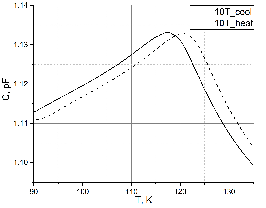NANOSYSTEMS: PHYSICS, CHEMISTRY, MATHEMATICS, 2017, 8 (6), P. 835–838
Phase diagram for K(1-x)(NH4)(x)H2PO4 (x = 0 – 0.15) solid solutions embedded into magnetic glasses
P.Yu. Vanina – Peter the Great Saint Petersburg Polytechnic University, Polytechnicheskaya, 29, St. Petersburg, 195251, Russia; p.yu.vanina@gmail.com
A. A. Naberezhnov – Peter the Great Saint Petersburg Polytechnic University, Polytechnicheskaya, 29, St. Petersburg; Ioffe Institute, Polytechnicheskaya, 26, St. Petersburg, 194021, Russia; alex.nabereznov@mail.ioffe.ru
A. A. Sysoeva – Ioffe Institute, Polytechnicheskaya, 26, St. Petersburg, 194021, Russia; annasysoeva07@mail.ru
V. I. Nizhankovskii – International Laboratory of High Magnetic Fields and Low Temperatures, Gajowicka, 95, Wroclaw, 53421, Poland; nizhan@ml.pan.wroc.pl
B. Nacke – Leibniz University of Hannover, ETP, Wilhelm-Busch-Street, 30167 Hannover, Germany; nacke@etp.unihannover.de
Effect of magnetic field application on phase transition in nanostructured solid solutions (1-x)KH2PO4 – (x)(NH4)H2PO4 at x = 0, 0.05 and 0.15 has been studied by dielectric spectroscopy at B = 0 – 10T. The samples have been prepared by impregnation of magnetic porous glasses by KDP-ADP solid solutions. The average pore diameter in glasses was 50(5) nm. The temperatures of the ferroelectric phase transition have been determined, and the phase diagrams for these nanocomposite materials (NCM) on cooling and heating (including at magnetic field application) were constructed. The interface “matrix-nanoparticles”
was shown to play the principal role in phase diagram formation.
Keywords: ferroelectrics, antiferroelectrics, phase diagram, nanocomposite materials, magnetic porous glasses.
DOI 10.17586/2220-8054-2017-8-6-835-838
